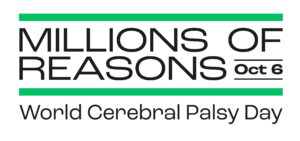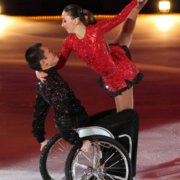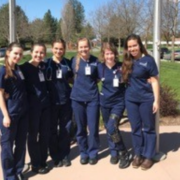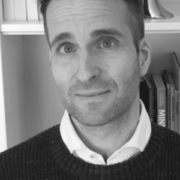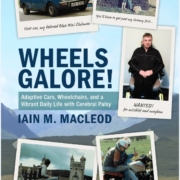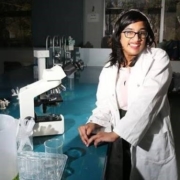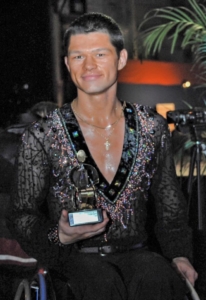 Twenty-nine year old Maxim Kiselev lives in in Moscow, Russia, with his beautiful fiancé, Natalia, and lives with spastic tetraplegia which mainly affects the left side of his body. Maxim is a wheelchair dancer, and does both ballroom style dancing and figure skating on ice.
Twenty-nine year old Maxim Kiselev lives in in Moscow, Russia, with his beautiful fiancé, Natalia, and lives with spastic tetraplegia which mainly affects the left side of his body. Maxim is a wheelchair dancer, and does both ballroom style dancing and figure skating on ice.
He initially took up dancing at 14 years’ old as a way to try to strengthen his left side – in particular his left arm and fingers which had limited functionality at the time.
“In the beginning I was simply excited at the thought of doing something new that doctors thought could improve my quality of life,” Maxim said.
His plan was to be the standing partner of a person using a wheelchair, however his challenges with coordination and balance meant this wasn’t an easy feat, and he eventually realised that it wasn’t going to be possible.
“When my mother and coach suggested I get into a wheelchair myself, as the severity of my disability allowed me to do that, I was furious.
“I worked so hard through the years to be able to walk! Getting into a wheelchair felt like a setback. But they insisted and managed to convince me. I got into a wheelchair and was quickly pleased by my progress,” Maxim continued.
After two years of wheelchair dancing, Maxim attended a paradancing show, which featured really talented professional dancers.
“At the show I realised that there was a whole new level I could get on.
“My mother found a ballroom latin dance club and they had a coach who was willing to work with me, although he had no experience with people with disabilities in a wheelchair,” Maxim said.
A month later, Maxim was thrust into competing in the Eurasia Cup 2007. This was his first tournament, and he was a complete newbie, but he managed to place fourth in the solo category.
The possibilities without a partner are pretty limited, so Maxim went on in search of a dance partner. With only a few weeks practice under his belt with his first partner, the pair took part in their first tournament—the Open Belarus Championship 2007, where they were Vice Champions, which Maxim says was “surprising and encouraging.”
Finding a partner
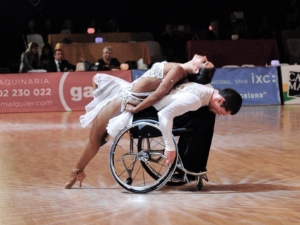 While his start in partner dancing was good, he says finding the right partner (or any partner!) wasn’t easy, and he faced a lot of discrimination along the way.
While his start in partner dancing was good, he says finding the right partner (or any partner!) wasn’t easy, and he faced a lot of discrimination along the way.
“My mother would get in touch with the girls’ parents or coaches and the vast majority had a very rude reaction as soon as they found out I was disabled. Nowadays the attitude towards disabled people in Russia started to change slowly, but back then it was pretty bad.
“The people my mother contacted didn’t even want to know what the deal was, they just refused to have anything to do with disability. Some other people (about 10%) were more open minded and polite, but they had a hard time figuring out what wheelchair dancing was and how a person in a wheelchair could dance,” shared Maxim.
Most of the time, Maxim’s partners would be noticed for their talent during competitions and would move on to a partner who didn’t have a disability. In the course of ten years, Maxim says he had about 14 different partners.
Check out Maxim in Virtual Reality!
Learning from coaches
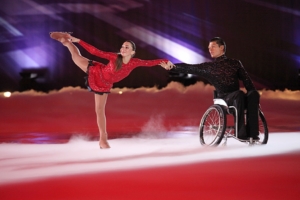
His coaches really drove him to grow and develop as a dancer, and even without experience, came up with some great techniques to help him manoeuvre the chair more easily.
“In the beginning we were building the choreography around the standing dancer and my part was choreographed subsequently to make me fit in with the wheelchair. With time we really managed to adapt choreographies originally designed for two standing dancers and incorporate a great number of traditional elements of Latin dance,” said Maxim.
His dancing was elevated even further when his third coach forced him to think like a standing dancer. Maxim says this is what helped his performance to look like dancing rather than just rolling back and forth on the dance floor.
“He taught me how to do more than simply execute dance moves, he taught me to feel the music and the dancing,” Maxim said.
Not without its challenges
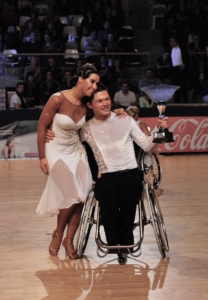 While Maxim’s dance skills grew to be exceptional, partner dancing with one standing and one seated dancer could be quite tricky!
While Maxim’s dance skills grew to be exceptional, partner dancing with one standing and one seated dancer could be quite tricky!
Maxim said:
“The most difficult part was the closeness. The key aspect of dancing is that the two partners are very close to each other. This must be the same in wheelchair dancing. The standing partner must stand really close to the wheelchair… which means that any wrong movement with the wheelchair could cause a foot or toe injury for her!
“We had to go very slowly until the movement was perfectly assimilated and performed without staring at my partner’s feet!”
Dancing with CP
Maxim says one of the biggest challenges he faces is the fact that his left side is significantly weaker than his right. His left arm tends to repeat the movements that his right arm does, which can be a big problem when he’s trying to do asymmetrical movements or lead his partner.
“It can disrupt the rhythm of the dance and instead of feeling guided, my partner might get confronted with a counter-current momentum,” said Maxim.
Maxim also has to work with the lack of sensitivity in his left arm.
“When I have to move it while staring in the opposite direction, I don’t exactly know what it is doing. Managing this requires tremendous effort, and because of the lack of sensitivity, I also often hurt my fingers in the wheel,” said Maxim.
After 10+ years of dancing, Maxim says that making the same movements on both sides (rolling shoulders, turning etc.) with the same amplitude and speed is a challenge. This, he says is something he and his coach have managed to work around, and now, these weaknesses have been turned into strengths.
It also helps when his partners have more body strength than average dancers as sometimes they need to help Maxim stop the wheelchair, or pull it while remaining pretty and gracious.
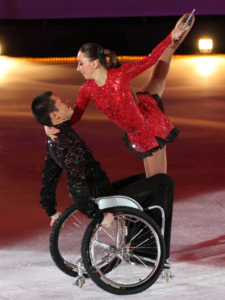
Proudest moments
Maxim says his greatest pride is having taken his dancing skills on ice. He is the first high level figure skater in a wheelchair, and still the only one to this day.
What’s next for Maxim?
Maxim is taking a break from dance at the moment because of health issues, but is filling his time with other exciting projects.
He recently participated in a Russian Virtual Reality Project—VRability—which aims to motivate people with disabilities to get more active in real life. You can read about Maxim here.
He’s also working on a wheelchair that will be lighter, more technologically advanced, and easier to handle than any other chair that he has used. He has a concept, and is looking for funding to build his first prototype!
You can follow Maxim and his fiancé, Natalia on Instagram – @nagrimakis
